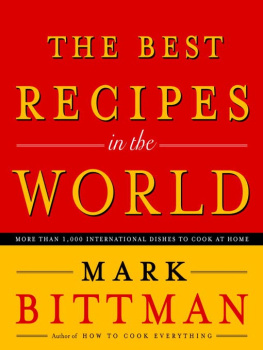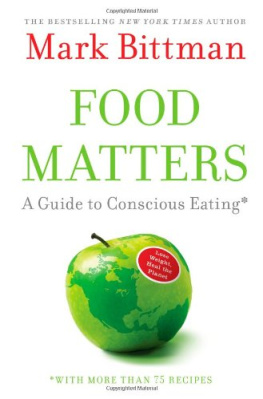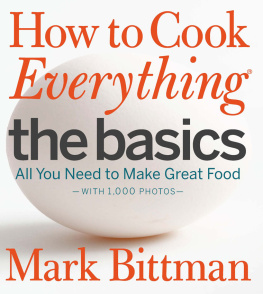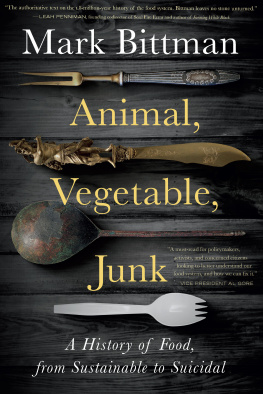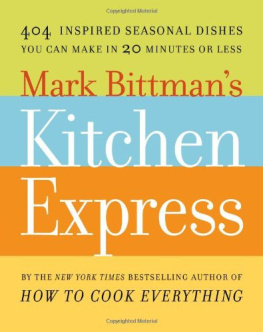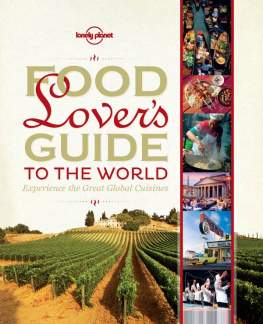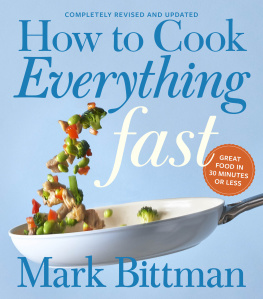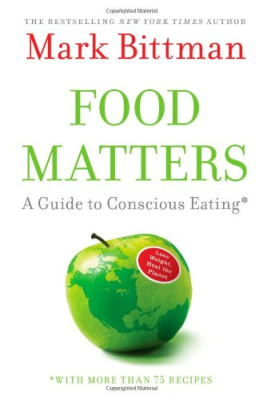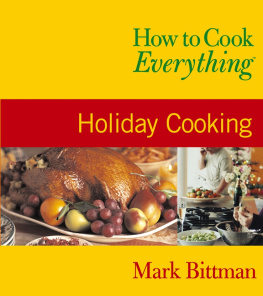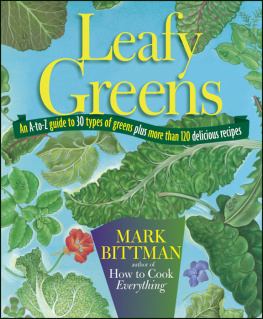Mark Bittman - The Best Recipes in the World
Here you can read online Mark Bittman - The Best Recipes in the World full text of the book (entire story) in english for free. Download pdf and epub, get meaning, cover and reviews about this ebook. year: 2005, publisher: Crown Publishing Group, genre: Home and family. Description of the work, (preface) as well as reviews are available. Best literature library LitArk.com created for fans of good reading and offers a wide selection of genres:
Romance novel
Science fiction
Adventure
Detective
Science
History
Home and family
Prose
Art
Politics
Computer
Non-fiction
Religion
Business
Children
Humor
Choose a favorite category and find really read worthwhile books. Enjoy immersion in the world of imagination, feel the emotions of the characters or learn something new for yourself, make an fascinating discovery.
- Book:The Best Recipes in the World
- Author:
- Publisher:Crown Publishing Group
- Genre:
- Year:2005
- Rating:4 / 5
- Favourites:Add to favourites
- Your mark:
- 80
- 1
- 2
- 3
- 4
- 5
The Best Recipes in the World: summary, description and annotation
We offer to read an annotation, description, summary or preface (depends on what the author of the book "The Best Recipes in the World" wrote himself). If you haven't found the necessary information about the book — write in the comments, we will try to find it.
The Best Recipes in the World — read online for free the complete book (whole text) full work
Below is the text of the book, divided by pages. System saving the place of the last page read, allows you to conveniently read the book "The Best Recipes in the World" online for free, without having to search again every time where you left off. Put a bookmark, and you can go to the page where you finished reading at any time.
Font size:
Interval:
Bookmark:
I dreamed about writing an international cookbook for thirty years, and I'm grateful to everyone who allowed me to convert my fantasies into reality It's literally impossible, however, for me to mention everyone who helped me, kind cooks worldwide who invited me into their homes and shared their skills, their warmth, and their families' food. How similar we all are when cooking and eating never ceases to amaze me.
I had plenty of help at home, too. Genevieve Ko Sweet worked hard and long in helping me determine the ultimate versions of the recipes you see here; Kate Bittman and Peter Mee-han also played key roles in getting the manuscript into shape.
At Broadway Books, my editor, Jennifer Josephy, managed the project (and me) in stunningly efficient fashion. Copy editor Chris Benton caught more gaffes than I care to admit, smoothed my not-always-brilliant prose, and helped me reorganize the book into the (I hope user-friendly) shape in which you see it. I'm happy to count Doubleday/Broadway publisher and president Steve Rubin among my friends, and I remain grateful for his professionalism as well.
The other staff at Broadway Books were also terrific. I worked most closely with Elena Park, Ada Yonenaka, Elizabeth Rendfleisch, Luisa Francavilla, Catherine Pollock, and Nicole Dewey. Many othersoutstanding professionals allworked hard on this massive project.
Some of the ideas that were spawned by this book found a home in stories that ran in the New York Times, where I happily work with Kathleen McElroy and Nick Fox. Pat Gurosky and Kris Ensminger have been terrific colleagues for years, and Barbara Graustark is inspiring, understanding, and supportive. Sam Sifton was my editor during much of the period I was working on this book, and there is no better. Other people to whom I will remain thankful forever are Linda Giuca, Louise Kennedy, Trish Hall, Rick Flaste, and Chris Kimball. My debt to Jean-Georges Vongerichten is equally enormous, though the rumors that he taught me how to cook are unfounded.
There was a period of researching this booka rather intense five or six yearsthat was especially challenging. I relied heavily on the support of many, many relatives and dear friends: Karen Baar, John Ringwald, David Paskin, Pamela Hart, Sherry Slade, Fred Zolna, Semeon Tsalbins, Bob and Mary Newhouse, Shari and Harry Sucheki, Joe and Kim McGrath, Jack Hitt, and Lisa Sanders. Special mention: the Baldinos, for being ideal neighbors.
To Angela Miller, Charlie Pinsky and John H. Willoughby people who are there for me every day my love and thanks. To Alisa X. Smith, who spent more time with me (and this book) than anyone else, I add my eternal gratitude. And to my parents, Murray and Gertrude, and my kids, Emma and KateI just consider myself lucky. xxx guys.
Here are a few ideas for ways to assemble some of the many dishes scattered throughout the book according to their regional traditions. But please don't take them too literally. In almost every instance you can trade recipes from one menu to another, as if you were in a restaurant, and still be reasonably authentic.
The oily sauces, MSG, and fortune cookies of American take-out joints serving Chinese food are as representative of that country's great cuisine as pizza is of that of Italyprobably better defined as American food.
But even recently, when we've seen better Chinese food here, because most Chinese immigrants come to the United States from places like Hong Kong and Taiwan, most of us have been exposed to only a sliver of real Chinese cuisinethe food that those immigrants have brought from the major cities of eastern and southern China. Central and northern Chinese culinary traditions, most notably Szechwan, are only now beginning to make inroads. Here are a few typical menus for Chinese home-style meals; each would serve about six, except for the Chinese Banquet menu, which could easily feed many more.
Siu may, which literally means roasted flavor, is the name for the savory-sweet meats you see hanging in the windows of urban Chinese restaurants.
Egg Flower Soup (page 115)
Roast Duck (page 325), Soy-Poached Chicken (page 274), or Barbecued Pork (page 373), served on Basic Long-Grain Rice (page 506)
Sliced oranges
Tea
Cream-Style Corn Soup (page 141) or West Lake Beef Soup (page 145)
Basic Long-Grain Rice (page 506)
Braised Whole Fish in Hot-and-Sour Sauce (page 260), Sea Bass or Other Fillets Wrapped in Bean Curd (page 228), or Stir-Fried Shrimp with Cabbage and Black Beans (page 213)
Quick-Braised Root Vegetables with Hoisin (page 499) or Stir-Fried Potatoes with Chiles (page 473)
Sliced oranges
Tea
Chicken and Watercress Soup (page 140)
Basic Long-Grain Rice (page 506)
Stir-Fried Pork with Asparagus (page 370), Soy-Poached Chicken (page 274), White Cut Chicken (page 273), or Steamed Dungeness Crab with Ginger (page 224)
Gai Lan (Chinese Mustard Greens) with Oyster Sauce (page 463) or Snow Peas with Ginger (page 470)
Seasonal fruit
Tea
Spicy Cold Celery (page 17)
Minced Shrimp in Lettuce Wrappers (page 213)
Basic Long-Grain Rice (page 506)
Drunken Chicken (page 273) or Lemon Chicken (page 314)
Gai Lan (Chinese Mustard Greens) with Oyster Sauce (page 463) or Snow Peas with Ginger (page 470)
Sliced watermelon or other seasonal fruit
Tea
Cold Cut Beef Shank (page 39) and Soy-Poached Chicken (page 274)
West Lake Beef Soup (page 145)
Stir-Fried Chicken with Walnuts (page 311) or Stir-Fried Spicy Shredded Beef (page 368)
Drunken Shrimp (page 212) or Shrimp with Peas and Ham (page 214)
Tea-Smoked Duck or Chicken (page 327) or Roast Duck (page 325)
Steamed Crabs with Soy Dipping Sauce (page 225)
Whole Steamed Sea Bass or Other Fish (page 261)
Egg Noodles with Spring Onions (page 536) or Fried Rice (page 506)
Sweet Rice Flour Dumplings (page 639)
Tea
Most Americans associate Japanese food with raw fish, rice, and soy sauce. These are all important aspects of the Japanese diet, but the cuisine is quite diverse, especially considering that it comes from a small island nation that existed in almost total cultural isolation for centuries. During that period, Japanese cuisine developed a personality based largely on a foundation of many foods that originated in China, like soy sauce, rice, and tofu.
Like all island nations, Japan has long depended on fish. Fresh seafood is grilled, fried, and steamed or served cold (or just barely warmed) with rice (sushi) or alone (sashimi). (Since sushi and sashimi are traditionally viewed as special-occasion foodslargely because raw fish tastes best when it's from fish that's exceptionally fresh, and that's never been easy to come byit is not generally made at home, so I haven't included recipes for it.)
Many Japanese recipes are well within the grasp of the non-Japanese home cook: tempura and other Japanese-style foods, teriyaki (a technique, not a bottled sauce), noodle dishes and soups, steamed dishes, and stews, many of which are based on dashi. And even though very little meat was eaten in Japan until it opened its borders to trade in the middle of the last century, it has created a sophisticated and delicious range of beef and pork dishesmany of which owe a debt to Korean and Chinese cooking.
Font size:
Interval:
Bookmark:
Similar books «The Best Recipes in the World»
Look at similar books to The Best Recipes in the World. We have selected literature similar in name and meaning in the hope of providing readers with more options to find new, interesting, not yet read works.
Discussion, reviews of the book The Best Recipes in the World and just readers' own opinions. Leave your comments, write what you think about the work, its meaning or the main characters. Specify what exactly you liked and what you didn't like, and why you think so.

